5 Use of video games
5.1 Introduction
In this chapter, the Ministry provides an overview of the use of video games. We will first present general statistics on the players, distributed by age and gender. We will then present figures showing how often the various groups play and how much time is spent playing games.
Statistics will also be provided for financial conditions associated with the purchase of video games and indicating which technological platforms dominate among players. Finally, we will present a separate study associated with knowledge of, use of and attitudes regarding Norwegian video games.
The statistical material in this chapter focuses on children and young people, who constitute the main target group for the Government’s policy in the area of video games.
The chapter is based on a number of sources. An important source is surveys conducted by Synovate (formerly MMI) on contract from the Norwegian Film Fund. Statistics have also been obtained from TNS Gallup and from Statistics Norway’s publication Norwegian Media Barometer 2006.
5.2 Who are the players?
The general conception of a “video game player” is a young boy. This is a conception that the video game industry has attempted to modify. A number of American reports attempt to depict the average user of video games as a responsible adult, cf. figure 5.1. For example, statistics from the American trade association Entertainment Software Association (ESA) show the average age of a “video game player” to be 33.
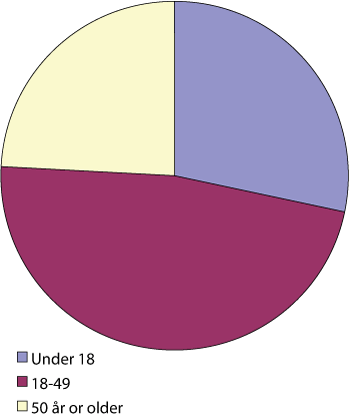
Figure 5.1 Age distribution of video game players.
Source Entertainment Software Association, USA
The statistics do not clearly show how this average has been arrived at, but it is probably based on everyone who states “I play video games ”. By asking the question in this way, it is possible to arrive at an average of 33. However, this is a somewhat one-sided interpretation. If we base the statistics on frequency of play, the picture is quite a different one. All Norwegian surveys show clearly that the frequency is greatest among children and young people. This is, for example, shown by the figures in Statistics Norway’s Norwegian Media Barometer for 2006, cf. table 5.1.
Table 5.1 Distribution by age of users of video games on a random day (2006)
| Age | 9–12 | 13–15 | 16–19 | 20–24 | 25–44 | 45–66 | 67–79 |
| Per cent | 51 | 39 | 22 | 19 | 8 | 5 | 5 |
Source Norwegian Media Barometer 2006, Statistics Norway
The typical video game player is thus seen, on the basis of this definition, to be much younger than 33. The figures in the ESA survey are consequently hardly based on frequency. The following presentation gives a more detailed account of frequency of use and time spent on using video games, distributed by gender and age.
5.3 How often do people play?
5.3.1 The age group 8–24 years
The above presentation provided an overview of which age groups play video games most frequently. Other interesting factors in this connection are distribution by gender and whether the frequency has increased over time.
Synovate has measured the media habits of children and young people over a number of years. One of the main questions in the survey is whether one has used a specific medium on a random day (“did you use … yesterday?”). Figure 5.2 shows the results for the video game medium during the years of 1995, 2000, 2003 and 2007.
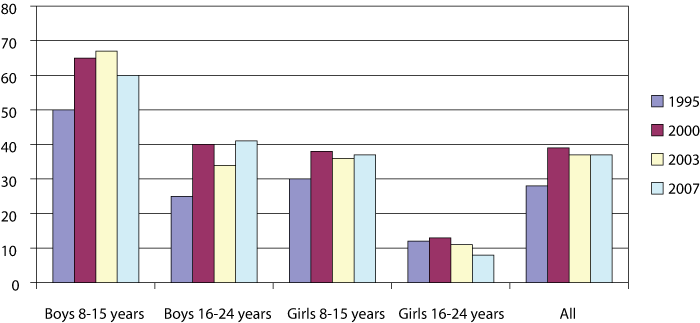
Figure 5.2 Use of video games on a random day 1995–2007. 8–24 years. Expressed as percentages.
Source Synovate
The use of video games on a random day showed a marked increase from 1995 to 2000, and rose from 28 per cent to 39 per cent in the category “all”. Use has remained quite stable during the period 2000 to 2007 at approximately 37–39 per cent. In the age group 8–24 years taken as a whole, four out of ten use video games on a random day.
Figure 5.2 shows clearly that it is boys aged 8–15 who play most often. Sixty per cent of all boys in this age group had played video games on a random day.
At the other end of the scale, we find girls between 16 and 24. Here the proportion who have used video games is extremely low, only 8 per cent in 2007. This clearly shows that video games are a medium with considerable variations of use in relation to gender and age.
An interesting characteristic of these two groups is that use has fallen in both of them. Among boys, use has fallen by seven per cent, which is not dramatic, but breaks the trend seen in previous year of increasingly more frequent play. The fall in frequency may be associated with competing media activities and the availability of attractive games for the various groups. The game industry has nonetheless had little success in raising the proportion of players among young women.
In the case of boys aged 16–24 and girls aged 8–15, the proportion of players lies relatively stable at around 40 per cent. Previous assumptions that boys and girls will continue with their game playing habits when they grow older do not hold water. The fall is marked for both sexes when they grow older. Taken as a whole, figure 5.2 shows that video games are still a medium that is most popular with young boys.
5.3.2 Children of 3–13 years
The above surveys only cover the age group 8–24. For the age group 3–7, Synovate has conducted a separate survey. Frequency in the use of video games for this age group is shown in figure 5.3.
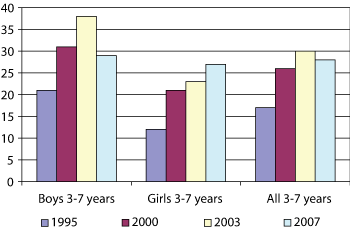
Figure 5.3 Use of video games on a random day 1995–2007. Children 3–7 years. Expressed as percentages.
Source Synovate
The figure shows that the average use of games by this group is lower than in the higher age groups. Only three out of ten used video games on a random day in 2007. In the case of this group of children, we do not find great differences between boys and girls. In 2007, girls play as often as boys. An interesting development is that girls in this group have increased their use of video games considerably during the period, from 12 per cent in 1995 to 27 per cent in 2007.
Figures from TNS Gallup may further alter this picture, cf. figure 5.4. In the age group 3–13, the proportion who have played daily increases with age. This is a phenomenon that is not detected by the age categories that Synovate operates with.
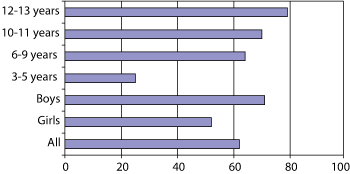
Figure 5.4 Proportion who have played electronic games on a random day in 2007. Expressed as percentages.
Source TNS Gallup
This figure too shows that boys play more frequently than girls. It shows moreover that the proportion who play every day rises steeply from 25 per cent in the age group 3–5 years to 79 per cent in the age group 12–13 years. Thus, eight out of ten 12–13 year-olds play video games on a random day.
Viewed as a whole, one can say that video games are used increasingly often until one is 13–15 years old, and that the use then falls. Boys play video games much more often than girls.
5.4 How long at a time do people play?
5.4.1 The age group 8–24 years
Even if one plays often, one does not necessarily play for long at a time. An interesting question is therefore how much time is used to play video games, and whether the time consumption increases. This is associated with different explanations of the factors that influence the time consumption. Here, new popular games, such as online role-playing games ( World of Warcraft, Anarchy Online , etc.) may have significance. These are games that players usually use a lot of time on. On some games (so-called “casual games”) people use little time.
Figure 5.5 shows how much time players between 8 and 24 (i.e. those who answered “yes” to the question of whether they had played video games) used on average on playing games.
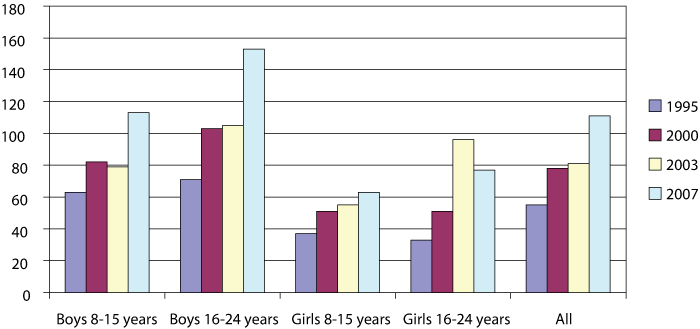
Figure 5.5 Time spent on video games on a random day, 1995–2007. Average time in minutes among those who used the medium. 8–24 years.
Source Synovate
The figure shows a clear tendency for increased time spent on video games by all groups during the course of the period, except for girls between 16 and 24. Although the frequency has remained stable or fallen, the time consumption has increased considerably. In the case of the group that used video games most often (boys 8–15, cf. figure 5.2), the figure shows that the time consumption increased by 34 minutes from 2003 to 2007. Those who play, play for considerably longer than they did in 2003. This may be associated with the above-mentioned increase in popularity in recent years of online role-playing games, which demand a great deal of time from players. Even more striking is the increase among boys aged 16–24. Here, the time consumption by players has increased by approximately 50 per cent from 2003 (almost 50 minutes). Players in this age group also use considerably more time on playing than the younger boys; on average, approximately 2.5 hours per day. Thus, they play less often, but those who play use more time on it.
Among girls, we find a small increase in time consumption in the age group 8–15 years, while time consumption has fallen – after increasing steeply from 1995 – for the age group 16–24 years. Both age groups use approximately half as much time on this activity as boys in the same age groups.
If we compare figure 5.2 with figure 5.5, we see that boys between 8 and 15 play most often, while boys between 16 and 24 play for longest/most.
5.4.2 Children 3–7 years
As regards time consumption too, Synovate has conducted a separate survey of smaller children. Figure 5.6 shows the time consumption for, respectively, all boys and girls in the age group 3–7.
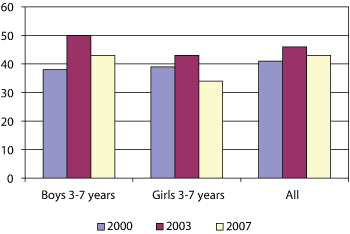
Figure 5.6 The number of minutes used on video games. Children 3–7 years.
Source Synovate
Here too, we find great similarities between boys and girls in this age group. The time spent on video games fell slightly from 2003 to 2007 for both boys and girls, although the fall was somewhat greater for girls. Of course, this age group uses much less time on media consumption as a whole than the older age groups since, as a rule, they have less time at their disposition before bed-time. However, there is time for over half an hour of video games. The range of video games available to children in this age group is not very large.
5.5 Use of different platforms
5.5.1 Frequency, children 3–13 years
In the survey MedieBarn 2007, TNS Gallup has surveyed what types of platform children play on. In this connection, platforms are PCs, consoles (PlayStation, XBox, etc.) and hand-held consoles (Gameboy, etc.). Figure 5.7 shows the distribution of the use of the various platforms.
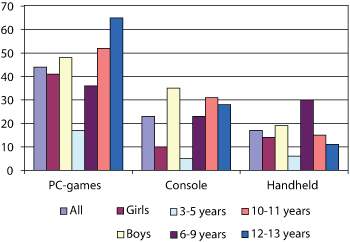
Figure 5.7 Proportion who have used the various platforms on a random day 2007 (percentage).
Source TNS Gallup Mediebarn 2007
PC games are unquestionably most popular among the older children, where 65 per cent of the age group 12–13 years have used such games on a random day. It is also clear that there is a steady increase in the use of PC games with increasing age. There are no major differences between boys and girls.
As regards consoles (TV games) there is a big difference between the sexes. Only 10 per cent of the girls use such games, whereas 35 per cent of the boys do so. In this case, use increases markedly from 3–5 years of age to the older age groups, but the difference is not very great between the three other age groups.
Hand-held games are by far the most popular in the age group 6–9 years. Altogether 30 per cent of these children play hand-held games on an average day. There is a clear drop in the use of these games when children reach 10–13 years. There is a certain tendency for boys to play more hand-held games than girls.
5.5.2 Time consumption children 3–13 years
TNS Gallup has also measured the amount of time this group of children use on the various platforms. Figure 5.8 shows time consumption distributed by age and gender.
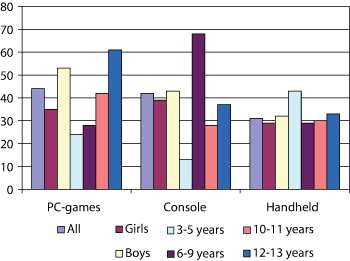
Figure 5.8 Time consumption of the various platforms distributed by age and gender 2007.
Source TNS Gallup Mediebarn 2007
There is a clear tendency to use more time on TV games (consoles) and PC games than on hand-held games. There are also big differences in time consumption between the various age groups. 6–9 year-olds use 68 minutes per day on TV games as against only 28 minutes on PC games and 29 minutes on hand-held games. 3–5 year-olds, for their part, use only 13 minutes on TV games and 29 minutes on hand-held games.
5.6 Access to equipment
In order to be able to play video games, one must have access to equipment: PCs, consoles of different kinds or hand-held consoles. In the above-mentioned survey, TNS Gallup has determined the access to game machines of the age group 3–13 years.
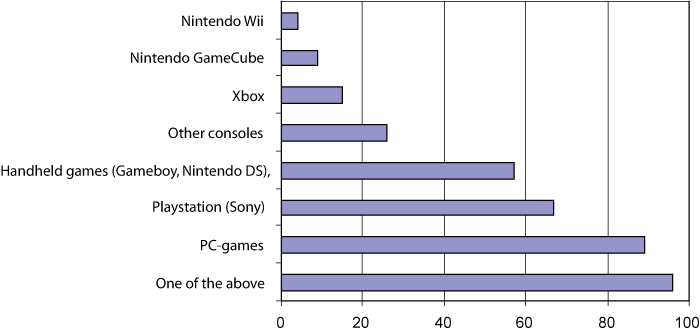
Figure 5.9 Access to video games equipment in the home 2007. Children 3–13 years.
Source TNS Gallup Mediebarn 2007
According to TNS Gallup’s survey, virtually all children (96 per cent) have access to technical equipment in the home that video games can be played on. The greatest access is to PCs, but Sony PlayStations and hand-held consoles are also found in very many homes. The newer consoles (Xbox, Wii) are not yet widely available.
5.7 Spending and purchasing patterns
Synovate has also asked children and young people whether they use money on games or persuade their parents to do so. Figure 5.10 shows the development since 1995.
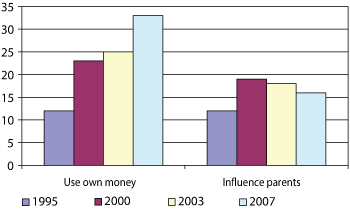
Figure 5.10 Proportion who use money on games/influence their parents to purchase games, 1995–2007. 8–24 years.
Source TNS Gallup Mediebarn 2007
The proportion who themselves use money on games has increased considerably, from 12 per cent in 1995 to 33 per cent in 2007. In this group, one out of three children uses his or her own money to purchase games. This may reflect increased purchasing power for children and young people during the period since there is little to indicate that the price of games has gone down. The decision concerning which games to buy is thus made relatively often by the children and young people themselves. Figure 5.11 shows how this is distributed in the various age groups and between boys and girls.
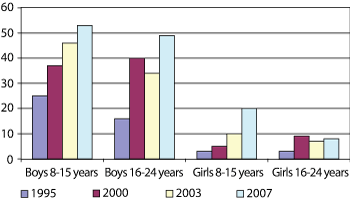
Figure 5.11 Proportion who use their own money on video games, 1995–2007.
Source TNS Gallup Mediebarn 2007
We see here that approximately half of the boys in both age groups use money themselves on video games, and that the proportion is increasing. The proportion of girls who use money themselves on games is considerably lower, although it has increased somewhat in the youngest age group.
5.8 Norwegian video games – knowledge and attitudes
In October 2007, on behalf of the Norwegian Film Fund, Synovate conducted a survey of parents’ knowledge and attitudes concerning Norwegian produced video games. The target group for the survey were parents with children in the age group 5–12 years.
5.8.1 Use
The parents were asked how often their children play Norwegian games. Figure 5.12 shows how often the parents assert that their children play Norwegian games.
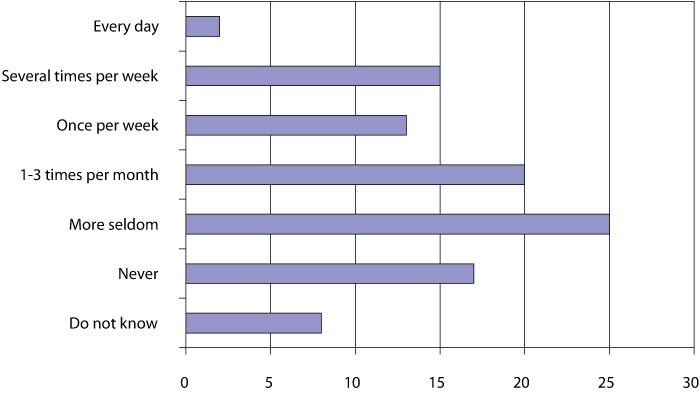
Figure 5.12 How often children play Norwegian games, 5–12 years.
Source Synovate
The figure shows that children in this age group play Norwegian games relatively seldom. Seventy per cent play once a month or less often. Since the knowledge of Norwegian games among parents is generally low (they do not know which games are Norwegian), there is also some uncertainty associated with the responses. Some localized foreign games with Norwegian language may have been regarded by the parents as Norwegian games. A certain over-reporting can therefore be assumed.
5.8.2 Knowledge
A number of Norwegian produced games have been released in recent years. Some of these are based on well-known brand names from films, television or the like, while others are original concepts. Synovate asked parents which Norwegian video games they can name without being given titles – so-called “unassisted knowledge”. This gives an indication of consumers’ lack of awareness concerning Norwegian video games, cf. figure 5.13.
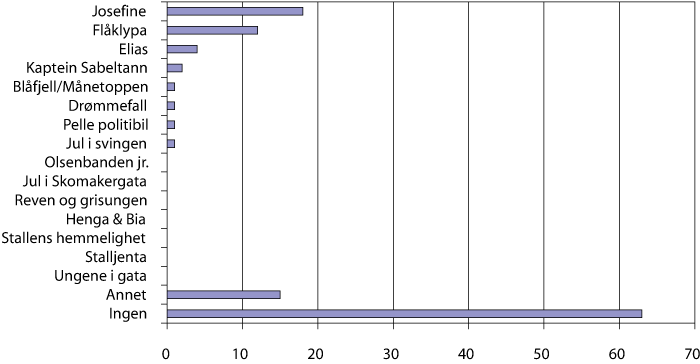
Figure 5.13 Unassisted knowledge of Norwegian video games. Parents.
Source Synovate
The unassisted knowledge of Norwegian video games is extremely low. Two games, Josefine and Flåklypa , are the only ones that have succeeded in creating names for themselves in the market. Well under half of those asked managed to give the name of a single video game without assistance. Background data indicates that the proportion is somewhat higher in groups with high education and high incomes, but knowledge is generally extremely low. This indicates that the Norwegian games are poorly marketed towards parents.
Knowledge is much greater when the parents are given the names of the games. This is probably because most of the games are based on popular products. Figure 5.14 shows knowledge when the names of the games are provided.
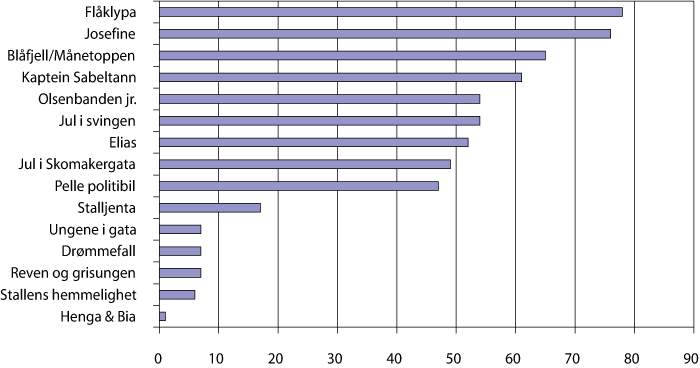
Figure 5.14 Knowledge of Norwegian games when the names are provided. Parents.
Source Synovate
Titles that are familiar through TV series and films have a particularly high recognition factor. Flåklypa scored 78 per cent, Jul i Blåfjell 65 per cent and Captain Sabertooth 61 per cent. It is nevertheless uncertain whether the consumers know of the game or are only familiar with the film or TV series. On the other hand, the figure for Josefine is very high – 78 per cent. This is a game that is broadly marketed via comics, activity magazines, etc., but which is not based on a well-known IP, cf. 2.4.2.
5.8.3 Attitudes
Synovate has surveyed the attitudes of parents to Norwegian games. Here, the result is relatively very positive, when one takes into account the low use and knowledge of Norwegian games. Figure 5.15 shows the main results.
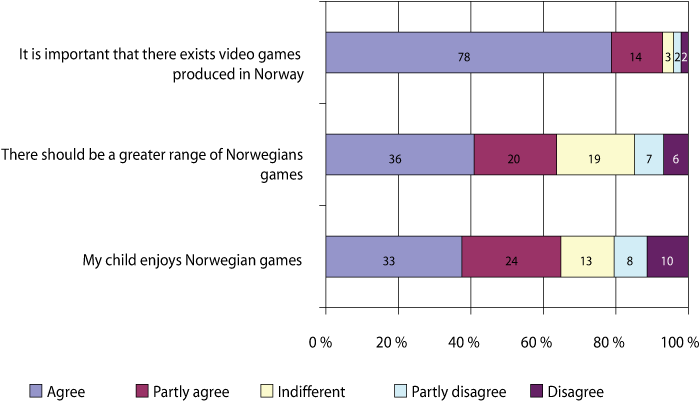
Figure 5.15 Attitudes among parents regarding Norwegian games.
Source Synovate
The attitudes were on the whole positive, and very few of the parents were negative to Norwegian games. This may indicate a certain potential market for more Norwegian games, although only just over half of those asked held the view that there should be a greater available range of these games. However, most considered it important that Norwegian games were available.
5.9 Gender differences
The survey presented in this chapter shows considerable differences between the sexes. This may be associated with the content of the games.
Surveys conducted in 2003 and 2006 by the Norwegian Media Authority, cf. 8.4, also indicate the existence of differing game preferences between boys and girls. As regards the choice of games, boys state a preference for action in the form of sports games and shooting, as well as military strategy games. Girls prefer social strategy games and games where violence and conflicts are concealed in the story. The girls also state that they prefer to have control of the game situation, for example in games such as The Sims .
Many popular video games allow building of characters and complex stories, and reward problem-solving and patience as much as aggression. These are game qualities that are attractive to both boys and girls.
Recent research shows that online games have become extremely popular among women. This is an indication of the importance of the social elements in video games for the pleasure they provide. In some people’s view, this change may be related to the anonymity and reduced stereotypical behaviour towards female players in an online setting. In the virtual world, women have the opportunity to compete against male participants regardless of gender.
5.10 Game cultures
A traditional picture of a game enthusiast is that of a socially isolated individual sitting in front of a screen all day. This view is no longer correct. Playing habits and use of the game medium have changed radically. Games are increasingly becoming a social activity that takes place both in the form of various types of social gathering and on the Internet.
5.10.1 The computer party, The Gathering
A popular game event in Norway is the computer party The Gathering. Every Easter, approximately 5000 computer-interested young people participate in this event at the Vikingskipet Olympic Arena in Hamar. Professor Birgit Hertzberg Kaare at the University of Oslo has studied this game culture for several years. Her survey shows that when the young people themselves describe their culture, they stress that they appreciate cooperation, social relations and friendship. The participants also tell that they view their interest in computers as an important doorway to job opportunities. Professor Kaare points out that technology-oriented young people are a resource that should be exploited more and should be cultivated by the authorities, researchers and the school system.
The Gathering has become a great success, and is one of the high points of the year for many game enthusiasts. For many people, this is a social gathering where they meet friends and acquaintances, other game-interested persons and, not least, people they have got to know via chat groups on the Internet. The social aspect is therefore a major reason why The Gathering has become so popular. The Gathering is very technology-oriented, and is therefore often associated with a male culture. Previously, very few girls took part in these gatherings, but in recent years the picture has changed somewhat, and the female contingent has increased to approximately 20 per cent.
The Gathering is run by the NGO KANDU: Kreativ Aktiv Norsk Dataungdom [Creative Active Norwegian Computer Youth]. KANDU is a member of Hyperion – Norsk Forbund For Fantastiske Fritidsinteresser [Hyperion – Norwegian Federation for Fantastic Freetime Interests]. Hyperion receives support from Frifond (NOK 1.56 million in 2007).
5.10.2 Net communities
In parallel with the strong increase in online games, a number of net communities for video game players have been established. These are websites dedicated to video games. Net communities for players can be classified as follows:
General net communities devoted to almost everything that has to do with video games. These do not necessarily make any distinction between console games and PC games. Norwegian net community www.gamer.no is an example of this category.
Net communities that focus on a few specific online games, but are open to most players. An example is www.battlefield.no.
Net communities that are reserved for a small group of players. These restrict membership, and are often referred to as “clan sites”. An example is www.dmscrew.org.
Net communities dedicated to a single type of game platform, regardless of game. An example is www.wii-fan.net.
The distinction between the second and third categories may be somewhat vague. This particularly applies to large “clan sites”, where admittance criteria are not very strict. Net communities in category 2 have grown rapidly throughout the world.
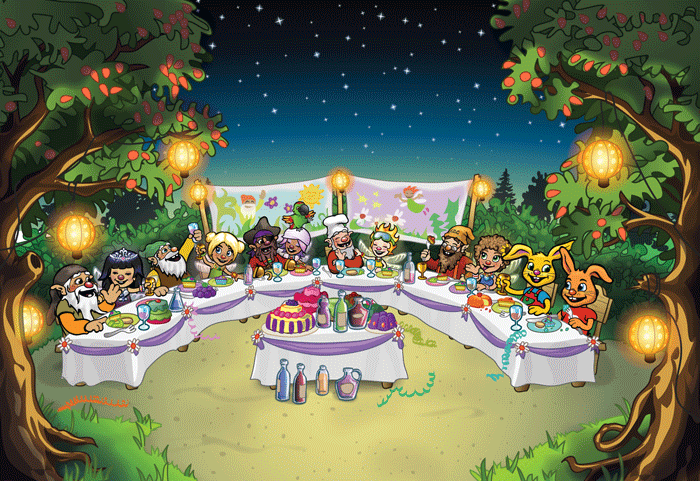
Figure 5.16 Josefine.
The many video games about the rabbit Josefine and her friends were developed by the Norwegian company Pinjata. The Josefine character is also used in comics and other products, and is the original brand name that is best known of all Norwegian video games.
Source Pinjata
The Norwegian net communities for video game players are mainly run by groups of enthusiastic amateurs. This means that articles written and published on the websites as well as the graphic work and operation of technical equipment are all carried out by people who are so dedicated to the net community that they are willing to work for it free of charge.
On a net community, users can play against each other by logging on to specific game servers, hire server capacity, discuss in forums, read game reviews, upload their own videos recorded during play (so-called “frag movies”), etc.
5.10.3 eSport
eSport is a concept that has emerged in recent years. It involves regarding video game playing as a serious branch of sport. Not all games are suitable for eSport. The games must have multi-player functionality. It is also important that the game has a large user group. Some of the most popular eSport games are Counter Strike, Half Life, Battlefield and Warcraft 3 .
Competitions, where teams can win large and small money prizes, are held world-wide. Such competitions are particularly popular in Asia, where money prizes can be equivalent to several hundred thousand Norwegian kroner, and where the finals of such tournaments are often shown on TV.
eSport communities around the world organize themselves in different ways. In Germany, where the eSport community has become very large, there are a number of leagues (one for each game). Terminology mirrors that of the world of sport with terms such as Counterstrike Premier League . In Norway, players interested in eSport have organized themselves in an association called the Norwegian e-Sport Community.
A group of players who train together is called a clan. Clans may train together for several hours each day in order to develop tactics and skills. Some of these clans have attained legendary status in video game communities.
The traditional media have taken an interest in developments within eSport. This has resulted in increasing coverage of big events and matches where high-profile teams compete. The NRK, among others, has shown a direct broadcast of a Battlefield match on web TV.
5.11 Summary
Viewed as a whole, children are seen to use video games increasingly often until they are 13–15 years old, and the frequency of use then falls. Boys play video games much more often than girls. The average frequency of the use of games by small children in the age group 3–7 years is lower than in the older age groups. Only three out of ten have used video games on a random day. In the case of the smallest children, we do not find big differences between boys and girls.
Among persons between 8 and 24 years of age, there is a clear tendency for increased time consumption on video games in all groups, except for that of girls between 16 and 24. However, the time used on video games by smaller children fell somewhat from 2003 to 2007 for both boys and girls, although the fall was rather greater in the case of the girls.
According to TNS Gallup’s survey “MedieBarn 2007”, virtually all children (96 per cent) have access to technical equipment that video games can be played on. PC games are unquestionably most popular among the older children, and there is a steady increase in the use of PC games with increasing age. There are no major differences between boys and girls. As regards consoles (TV games) there is a big difference between the sexes, and the use of consoles increases markedly with age. Hand-held games are by far the most popular with the younger age groups, and falls with increasing age. There is also a clear tendency to use more time on console and PC games than on hand-held games.
The proportion who use their own money on games increased considerably from 1995 to 2007.
A survey shows that children between 5 and 12 years play Norwegian games relatively seldom. The knowledge of Norwegian video games among parents is extremely low. The attitudes towards Norwegian games are primarily positive.
Surveys show that game preferences differ between boys and girls. Boys prefer action in the form of sports games and shooting as well as military strategy games. Girls prefers social strategy games and games where violence and conflicts are concealed in the story.
Various types of social community have sprung up in relation to video games, both in the form of net-based play and various kinds of game party. Video games are regarded by many people as a serious branch of sport, so-called eSport.